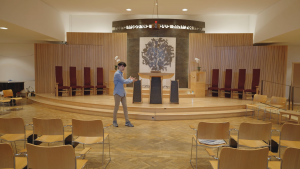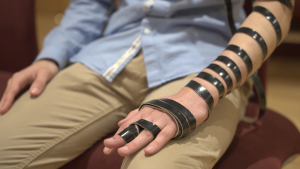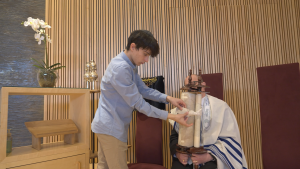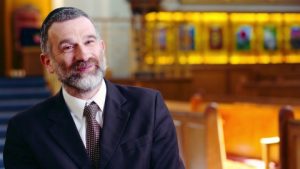Welcome to the Jewish festival of Sukkot, which is celebrated in the autumn soon after Yom Kippur. Lasting for a whole week, Sukkot is sometimes called the Feast of Booths, and it’s all about remembering the time when the Israelites lived in tents in the desert after escaping from slavery in Egypt. To mark the festival, Jewish families build a sukkah, a temporary hut, often decorated with fruits, vegetables and leaves. They eat their meals inside it, and in some traditions even sleep there. We explore the use of the “four species” the etrog (a citrus fruit), the lulav (palm branch), myrtle and willow and how they are shaken together during prayers. Sukkot is both a harvest festival and a spiritual reminder to be thankful for food, shelter, freedom, and the importance of welcoming others into your home!
Transcript
Sukkot is, I think, the happiest festival of the Jewish year.
It's a harvest festival. So at this time we will be praying for rain, which we get most days anyway, so we probably won't have to pray that hard for that, I wouldn't have thought.
We thank Hashem or God for everything that Hashem has given us.
So we celebrate Sukkot by building a sukkah, which we have behind me.
Sukkot is the celebration of the Jews escaping from Egypt and wandering in the desert for 40 years. They have to have somewhere to live. So they built these booths and that is what we are celebrating.
It is a hut that we build with wood, metal poles. You can make edible Sukkah's. It symbolises the houses that our ancestors, the Israelites, built in the middle of the desert.
Sukkot is when we build a sukkah and make and eat in it, and it lasts for seven days.
However, outside of Israel, many communities make it last for eight days. This is to do with being absolutely sure of the starting timing by seeing the full moon. It's the same time in the Hebrew month. It's always around September. October. But why do we do Sukkot in the first place? Well, there's a number of reasons. It's a harvest festival, so the harvest would have come in and you need to celebrate. So when you see our sukkah, you'll see we always have fruit and vegetables hanging up in it. It's also a festival where we remember the journey of the children of Israel from Egypt to Israel long, long, long time ago, recorded in our Bible, in our Torah. And it says there that the Israelites had to live in temporary structures, which they called Sukkot. So when we build a sukkah, it's a little bit like having that experience ourselves. And there's another reason, which is if you're a farmer or if you're just somebody growing food, you need rain. And if you haven't got rain, it's not going to grow. So this festival is also a festival where we begin to pray for rain. So our community comes together and we create a sukkah, which is a temporary structure. It can't be a permanent building, and it's got to be made, if we can, out of natural materials. And what we'll tend to do is take bits and bobs out of our garden and use them to make the sukkah look beautiful.
They would provide shade during the day and shelter during the night, and obviously were not designed to be this far north because they're not quite rain proof. One of the great joys of Sukkot is getting to decorate our sukkah. It's a little bit like my Christmas tree. I have a box of decorations that I bring out every year. Memories come out of the box, things the kids have made, and it's really special. We also celebrate by inviting lots of guests into our sukkah, to celebrate in the festival, to enjoy hospitality and good food, and to keep each other warm.
Many people will sleep in the sukkah and, you know, literally barely walk out the Sukkah unless they're going to work. This is important because, you know, it is a celebration. Yes, we're praying for rain because it's harvest. I've had many meals in the sukkah and got absolutely drenched.
And we also have the four species which the Torah tells us to bring together and shake. They are the etrog, which is a giant citrus fruit. The lulav, which is the palm. hadass, which is myrtle and willow. Some people say that the citron, the etrog, represents our hearts. The palm represents our spine, which should be tall and proud. The hadass. The myrtle represents eyes because the leaves are eye shaped, and that we should look out on the world and see goodness before us. And the willow is the shape of our lips, so it represents our lips that we should only speak goodness in the world. And of course, with the citron being our heart, that it should we should have a good heart in the world as we go into this new year.
The etrog is really important because it's for someone who does good deeds and also knows about Torah, which is the Old Testament. If you like the Jewish Bible, I have a terrible sense of smell, but I'm told that it's got a wonderful sweet fragrance.
We wave them in six directions. We say a Baruch, which is a prayer. And then we wave them forwards, to the right, behind, to the left, up and down. We shake them in those different directions so that it encompasses the whole world, and that we are praying for rain.
On Sukkot we come to synagogue. We'll do that on Sukkot evening, and we'll do that on Sukkot morning. We'll do that for one day. In some synagogues. They'll do that for two days, and it'll be a beautiful service, a lot of celebration. Everybody gets the chance to shake the lulav. As we say, the Psalms called the Hallel in the Bible, these are Psalms 113 to 118, very specific set of psalms. And we know that Jews have been singing those psalms on Sukkot for 2000 years, maybe 3000 years. It's a very celebratory service, and it finishes by going out into the sukkah for what we call kiddush, for a lovely, special meal that we have together out in the sukkah.
I think I have two favourite things about Sukkot. The first is the smell of the etrog, which is incredibly fragrant. If I could bottle it, I would spray it all over myself. And my second favourite thing is being able to decorate our sukkah with memories and joys that we've packed away each year and bring out again.
My favourite part of Sukkot is when you go into the sukkah and eat food.
My favourite part is eating all the tasty food.
I like most about Sukkot decorating the sukkah because it's a really fun task, and I do it with my family and it always ends up with a really pretty outcome, which is what I love the most.
And then all the way through the festival of Sukkot, we'll continue waving the lulav. Often we'll have tea parties in the sukkah. Often schools come to visit our sukkah, and the sukkah will then be taken down. And that's it for the year.










